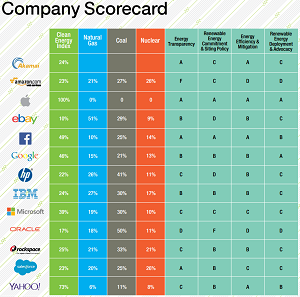News
AWS Responds to Calls for Energy Use Transparency
In an era of climate change and dire warnings of environmental disaster, datacenter energy usage is becoming a more important competitive metric to many companies, joining the traditional "speeds and feeds" evaluation criteria.
In this new era, Amazon Web Services Inc. (AWS) finds itself a focal point of concern for corporate disclosure of energy use and environmental impact. The company has come under increasing pressure from an environmental group and a consortium of customers asking it to disclose energy-related details of its massive network of distributed datacenters around the globe. Last week, it responded -- if somewhat indirectly -- to calls that it come clean with more environmental information in a blog post titled "Cloud Computing, Server Utilization, & the Environment."
To review, the circumstances leading up to this blog post include:
- Environmental organization Greenpeace issued a May report titled "Clicking Clean: A Guide to Building the Green Internet." It said: "Amazon's adoption of a 100 percent renewable energy goal,
while potentially significant, lacks basic transparency and, unlike similar commitments from Apple, Facebook or Google, does not yet appear to be guiding Amazon's investment decisions toward renewable energy and away from coal." AWS was one of two companies to score an "F" grade in any evaluation.
 [Click on image for larger view.]
AWS Gets a "D" Grade (source: Greenpeace)
[Click on image for larger view.]
AWS Gets a "D" Grade (source: Greenpeace)
- A group of 19 AWS customers wrote a letter to AWS exec Andrew Jassy, which suggested the company follow three steps to give customers confidence in its commitment to renewable energy, including: "Commit to transparency on energy and environmental performance, including publishing information describing AWS' energy and carbon footprints and progress toward renewable energy goals."
- Media outlets reported on the issue with headlines like: "AWS Customers Want More Information on its Renewable Energy Plans"; "AWS Customers Demand Amazon Come Clean On Cloud Power"; and "AWS Customers Demand Transparency On Energy Use."
That led to last Friday's blog post by AWS exec Jeff Barr, who didn't respond to the calls directly but addressed the larger issue in the context of what criteria was used in the Greenpeace report, among other issues.
"After reading the "Greenpeace, Renewable Energy, and Datacenters" blog entry from my colleague James Hamilton a couple of weeks back, I took a look at the Greenpeace report on datacenter power consumption and noted that it's pretty unusual for an environmental report to not feature energy conservation as a primary evaluation criteria."
Barr performed some math on some energy measurements and made some general observations about the environmental benefits of cloud computing, including:
- Cloud customers consume 77 percent fewer servers.
- Cloud customers consume 84 percent less power.
- Cloud customers reduce their carbon emissions by 88 percent.
Barr reaffirmed the company's commitment to 100 percent renewable energy usage and provided some backing evidence, along with pointing to its Sustainable Energy Web page that updated company information last month, reporting that about 25 percent of its energy comes from renewable energy now, on track for 40 percent by the end of next year.
"The environmental argument for cloud computing is already surprisingly strong and I expect that the overall equation will just continue to improve going forward," Barr concluded.
About the Author
David Ramel is an editor and writer at Converge 360.